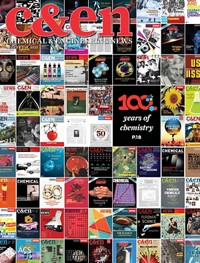Advertisement
Grab your lab coat. Let's get started
Welcome!
Welcome!
Create an account below to get 6 C&EN articles per month, receive newsletters and more - all free.
It seems this is your first time logging in online. Please enter the following information to continue.
As an ACS member you automatically get access to this site. All we need is few more details to create your reading experience.
Not you? Sign in with a different account.
Not you? Sign in with a different account.
ERROR 1
ERROR 1
ERROR 2
ERROR 2
ERROR 2
ERROR 2
ERROR 2
Password and Confirm password must match.
If you have an ACS member number, please enter it here so we can link this account to your membership. (optional)
ERROR 2
ACS values your privacy. By submitting your information, you are gaining access to C&EN and subscribing to our weekly newsletter. We use the information you provide to make your reading experience better, and we will never sell your data to third party members.
Publishing
Editorial: A peek inside C&EN’s 100 years of archives
by Alexander H. Tullo
April 22, 2023
| A version of this story appeared in
Volume 101, Issue 13
This is a guest editorial by Alex Tullo, C&EN’s senior correspondent for business.
When C&EN’s interim editor in chief, Mike McCoy, asked me to write this week’s editorial, I was honored. My task, he said, was to write “something about the archives” to pair with the From the Archives feature that I have been developing for C&EN’s 100th anniversary celebration.
McCoy may have soon regretted assigning me this task. I make extensive use of the archives in my reporting. But setting me upon the archives is like taking a hound to play fetch in a rabbit sanctuary. I become easily distracted. McCoy’s Slack messages light up intermittently with links to articles from a half century ago that amuse me and that I have to share.
The gems in the archives are impossible to ignore. For example, in the June 10, 1943, issue, I recently found a five-page article titled “Chemistry and the Motor Car Industry,” by Charles F. Kettering, general manager of General Motors’ Research Laboratories Division. Kettering was a giant in chemistry and engineering who helped develop the electric starter, leaded gasoline, and Freon refrigerant with GM’s major shareholder, DuPont. At the time, guest articles from such luminaries were common in C&EN.
Kettering’s article is a particularly good one, with passages like this:
“Perhaps you have never thought of it in this way, but an automobile is simply a chemical factory on wheels. It has every element of a compact, self-contained, portable chemical factory—storage tanks, mixing chambers, pipe lines, chemical reaction chambers, and waste product disposal. Its chemical raw products are gasoline and air, and it uses these products to produce large quantities of water and carbon dioxide.”
I, indeed, never thought about it that way. Though nowadays, we could do without the “large quantities” of CO2.
It’s clear from my many ventures into the archives that C&EN has always been on top of trends in chemistry and industry. And for that reason, reading the archives is like sneaking a peek at a first draft of history, complete with the attitudes and values of those times.
It is also fascinating to see how C&EN has evolved over the decades into the magazine that is familiar today. In its earliest days as Industrial and Engineering Chemistry, News Edition, it was practical and no frills. It covered meetings and new products, had plenty of classified ads, and was sprinkled with letters from chemists around the world about developments in their fields.
But much like the chemical sciences that it covers, C&EN has always experimented with new features and sections. Sometimes they didn’t pan out and were swiftly cast aside. In other instances, the new elements stuck around for decades and are still going strong.
Take Concentrates, for example. This section, presented for decades as two-page spreads of short news items in business, science, and policy, has always been popular with C&EN readers. In fact, when we redesigned C&EN in 2016, we leaned into the positive branding and put all our news in the front of the book under the Concentrates name.
We first ran Concentrates in the May 23, 1949, issue. We called them ConC&ENtrates, and they bore the tagline “Today’s news of the chemical world likely to influence the happenings of tomorrow.”
Newscripts, our back page of lighter science oddities, is another favorite. Some readers might remember K. M. Reese, a former C&EN managing editor, who wrote them from 1967 to 2004.
The first News-Scripts ran on July 10, 1943, and was made up of 15 small items. The lead piece taunts Germany for losing access to phosphate, critical for making fertilizers and without a substitute, from North Africa because of Allied advances. “Herr Hitler will find it rather difficult obtaining an ersatz for these quantities,” it reads.
I invite historically curious readers to explore the archives at pubs.acs.org/loi/cgeabj. Or readers can watch for the From the Archives feature, which appears on page 25 in this issue and will be published monthly for the rest of C&EN’s anniversary year.
Views expressed on this page are those of the author and not necessarily those of ACS.



Join the conversation
Contact the reporter
Submit a Letter to the Editor for publication
Engage with us on Twitter